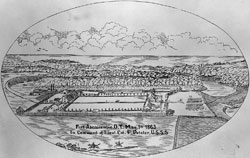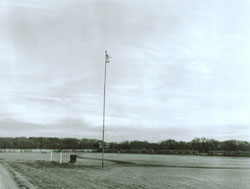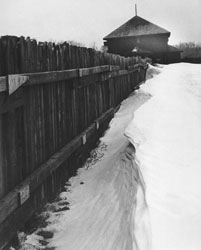We’ve launched a new web portal! Visit findhistory.nd.gov to search our collections.
Due to a road closure, the Killdeer Mountain Battlefield State Historic Site is temporarily closed.
Fort Abercrombie was at a crossroads of oxcart and wagon trails, and the Red River. It served as a gateway for supplies and goods headed for the Canadian West; miners heading to the gold fields of the Fraser River in Canada, Montana, Washington, and Oregon; military roads followed by Sibley; and later by settlers into Dakota. With the arrival of the railroad at Moorhead and Fargo, Fort Abercrombie waned in importance.
 On August 28, 1858, Lieutenant Colonel John J. Abercrombie established the fort bearing his name on the flat bottomland of an ox bow loop of the Red River. On July 25, 1859, the post was abandoned, but was re-occupied in July 1860. Because of the threat of flooding, this site was abandoned in 1859 when construction commenced on the higher ground of the river’s west bank
On August 28, 1858, Lieutenant Colonel John J. Abercrombie established the fort bearing his name on the flat bottomland of an ox bow loop of the Red River. On July 25, 1859, the post was abandoned, but was re-occupied in July 1860. Because of the threat of flooding, this site was abandoned in 1859 when construction commenced on the higher ground of the river’s west bank
When the Civil War broke out, soldiers of the regular U.S. Army were withdrawn from Fort Abercrombie, and replaced by units of the Minnesota Volunteer Infantry. When Captain John Vander Horck of Company D., 5th Minnesota Volunteer Infantry, arrived on March 29, 1862 to take command of the garrison, only three buildings had been completed: the Men’s Quarters (barracks), Commissary (food storehouse), and Commanding Officer’s Quarters. By late August a stable and guardhouse had also been added.
 In 1862, warfare broke out between the Santee or Eastern Dakota and the United States in Minnesota over a long litany of broken government promises and increased white settlement on Indian land. On August 17, 1862, a series of skirmishes along but not limited to the Minnesota River claimed many hundreds of settlers’ lives and an unknown number of Santee. Battles at places like New Ulm, Ft. Ridgely, Birch Coulee, and Wood Lake generated considerable national attention even as Union and Confederacy leadership blanched at the death toll at places like Shiloh and Antietam just months earlier.
In 1862, warfare broke out between the Santee or Eastern Dakota and the United States in Minnesota over a long litany of broken government promises and increased white settlement on Indian land. On August 17, 1862, a series of skirmishes along but not limited to the Minnesota River claimed many hundreds of settlers’ lives and an unknown number of Santee. Battles at places like New Ulm, Ft. Ridgely, Birch Coulee, and Wood Lake generated considerable national attention even as Union and Confederacy leadership blanched at the death toll at places like Shiloh and Antietam just months earlier.
Food and other annuities were due the Dakota under treaties whereby they had ceded land in Minnesota to the United States. A local crop failure in the fall of 1861, followed by a hard winter, was exacerbated by the failure of government payments and supplies to arrive during the spring and summer of 1862.
By August of 1862, the Dakota people were desperate for food and appealed to agency traders to sell them food on credit. Andrew Myrick was a trader on the Lower Sioux Agency in southwest Minnesota. Myrick’s comments, in a meeting with Dakota leaders and the Bureau of Indian Affairs agent, ignited the spark of war.
So far as I am concerned, if they are hungry let them eat grass or their own dung. Andrew Myrick, August 15, 1862
On August 18, 1862, after the Battle of Lower Sioux Agency, post trader Andrew J. Myrick was found dead, with his mouth stuffed full of grass. This photograph was owned by Nathan Myrick, Andrew’s brother, who was later the post trader at Fort Pembina.

I was never present when the white people where willfully murdered. I saw all the dead bodies at the agency. Mr. Andrew Myrick, a trader, with an Indian wife, had refused some hungry Indians credit a short time before when they asked him for some provisions. He said to them: “Go and eat grass.” Now he was lying on the ground dead, with his mouth stuffed full of grass, and the Indians were saying tauntingly: “Myrick is eating grass himself.” Jerome Big Eagle, or Wamditanka, (1827 - 1906) He surrendered in September 1862, was tried by the military commission and sentenced to death. Granted a reprieve, he was sent to a prison camp at Davenport, IA, and pardoned by President Lincoln in late 1864.
Responding to the uprising, President Abraham Lincoln appointed General John Pope to assemble troops from the Minnesota Third and Fourth Regiments to stop the violence. Additional troops were raised when Minnesota Governor Alexander Ramsey ordered Colonel Henry Hastings Sibley to quickly mobilize.
Address:
935 Broadway North
Abercrombie, ND 58001
Get Directions
Tuesday After Labor Day–Memorial Weekend Friday
Open for events, school tours, rentals, and by appointment.
Memorial Weekend Saturday–Labor Day
9 a.m.–5 p.m.
Daily
Site grounds are open year-round.
Contact Fort Abercrombie:
phone: 701.553.8513
email: shsaber@nd.gov
Contact SHSND:
phone: 701.328.2666
email: history@nd.gov